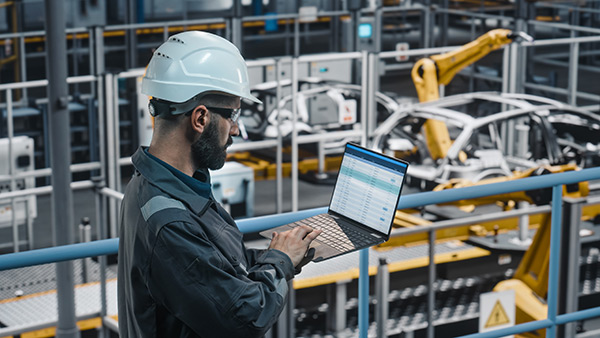Smart manufacturing technology incorporates automation and advanced data analytics to connect, automate and track a manufacturing business.

by Jerry Foster, CTO, Plex
Markets around the world have emerged from the pandemic and the remote work mandates that accompanied it. However, lasting impacts of the pandemic on workforces, worker preferences and workplace behavior persist as a lasting challenge for manufacturers.
Since January 2021, manufacturers added over 200,000 jobs every month. While this indicates growth in the industry, filling those jobs is a key challenge facing manufacturers. Manufacturers are struggling to recruit younger employees who still mistakenly view manufacturing as a dirty, repetitive job with little opportunity for upward mobility. At current employment rates, experts project that over two million manufacturing jobs could go unfilled by 2030.
But recruiting talented, young employees doesn’t need to be an uphill battle for manufacturers. The manufacturing facilities of today are not your grandfather’s factory of the 1970s. Through strategic technology investment and innovative approaches to manufacturing, enterprises can successfully attract the talent they need to embrace new ways of doing business and ensure business continuity.
Many non-manufacturing professionals still view factory work as a manual labor-intensive, low paying, dirty job – much like the ones their grandfather likely labored in when he started his career in 1970. In reality, many factory floors of today look like something grandfathers would have watched on shows like The Jetsons.
Today’s manufacturing facilities are equipped with technology and automation that removes the need for much of the repetitive, manual-heavy labor that used to be necessary. Industry 4.0 technologies like the industrial internet of things (IIoT), Artificial Intelligence (AI), and cloud-based applications enable the automation of many aspects of manufacturing operations. It is computers that run fully automated machines, heavy equipment and robots that perform most of the labor-intensive activities and heavy lifting, while IIoT sensors identify when and why production machinery should be maintained.
Advancements in manufacturing technology mean that today’s off-the-line facility workers act more as problem solvers and data analysts than manual laborers. Rather than being relegated to repetitively pulling levers or checking boxes on paperwork, manufacturing facility workers can analyze data to identify areas for optimization and increased productivity. Today’s factory worker needs to use technology to their advantage in modern factories. Manufacturers need to communicate that to prospective employees to show them the value of a career in manufacturing.
While the manufacturing facility of today is undoubtedly more attractive to younger workers, who are accustomed to using digital technology and devices in their day-to-day lives, manufacturing employees still need to come into the facility to do their jobs. But that’s unavoidable, right? In most of today’s manufacturing facilities, yes. However, the industry is rapidly approaching a future that enables manufacturing employees to execute their duties from the comfort of their homes.
During the pandemic, some companies proved that cloud technology enabled remote manufacturing and remotely managed factories with far less people on site. Manufacturing facilities that used cloud-based applications enabled workers to access facility systems from home, while those who used on-premise applications and systems sometimes struggled to manage operations remotely. At the former, some critical line-worker roles still needed to work in-person at the facility, but informed strategy, process optimization and management decisions could be generated by other workers at home.
With advancements in extended reality (XR), wearable technology, as well as robotics and cobots, even line-workers at manufacturing facilities might be remote workers in the future. Imagine a typical manufacturing employee, who wakes up for their day and pours a cup of coffee, then gets ready for their commute. Except their commute takes exactly two seconds. Why? Because their trip to work involves putting on a wearable headset that’s linked to a digital twin of the factory.
Represented in a fully digital environment, the digital twin of the factory reflects real-world information and updates based on data gathered from IIoT sensors in the facility. Workers can not only observe facility production information in real-time, but they can also virtually interact with machines and systems to adjust production and operations as needed. These virtual interactions are relayed to robots and machines on the factory floor, and the changes are enacted as though the worker was physically present in the facility.
The best part of this approach to facility management is that workers don’t need to leave their homes to work in a factory. This could be a deciding factor for many young workers who started their careers during or right before the pandemic. Many want work/life balance, which to them means a hybrid or fully remote work opportunity. Eliminating commute times also means that workers are better rested and less frustrated when they show up to work, increasing morale and productivity.
Additionally, not only will workers be able to work remotely from one factory, but they would be able to interact with plants around the world from home. Therefore, if a company has 10 plants globally, their workers could access data at all those locations to make an impact and take action at any of those plants.
Remote factory enablement also improves new worker training and onboarding. Because the facility digital twin is hosted in a virtual environment, workers can learn about and experiment with new processes and ways of doing their jobs without impacting the real-world facility or production. This means new workers can get hands-on training without jeopardizing tightly optimized factory floor processes, and existing workers can see how various strategies will impact workflows and productivity levels.
Enabling remote management of manufacturing facilities is a major step toward solving the workforce recruitment and retention challenge facing the industry today. Those that invest in remote workforce enablement will undoubtedly attract the best talent to their companies. Retaining that intelligent, innovative talent will be key to those companies’ ability to unlock and participate in the next wave of industrial revolution and game-changing technologies.

Jerry Foster is CTO and leads Plex’s technology strategy, along with research and design initiatives focused on next-generation cloud solutions for the manufacturing enterprise. A founding member of the Plex team, Jerry has been instrumental in the entire evolution of Plex, overseeing the technical transitions in each phase of our growth. Jerry earned his degree in Computer Science at Liberty University.
In this episode, I sat down with Beejan Giga, Director | Partner and Caleb Emerson, Senior Results Manager at Carpedia International. We discussed the insights behind their recent Industry Today article, “Thinking Three Moves Ahead” and together we explored how manufacturers can plan more strategically, align with their suppliers, and build the operational discipline needed to support intentional, sustainable growth. It was a conversation packed with practical perspectives on navigating a fast-changing industry landscape.